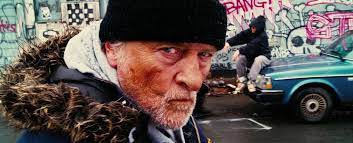At the start of 2023, I wrote an article about how Hollywood portrays billionaires, this article will be about how Hollywood portrays people who are homeless. In the 2000s sitcom Arrested Development a minor plot concerns the actor Tom Jane and the research he is doing for two films – one a gritty depiction of life on the streets, the other a family comedy about a “homeless dad” and is a useful way to gauge the portrayal of homelessness in films and television.
Charlie Chaplin

One of Hollywood’s first superstars Charlie Chaplin was most famous for his character the Little Tramp or The Tramp. This was a ridiculous, good-hearted, bumbling, unlucky but optimistic character, getting caught up in scrapes and escapades without meaning to. The Little Tramp endures real hardship and there many sad moments but he often greets them with a playful sense. In the famous scene in The Gold Rush where he and his companion boil and eat his shoe, the other man grimaces throughout the difficult task whereas The Little Tramp seems to enjoy the experience, twirling the laces like spaghetti and sucking the “flavour” from nails.
The Starving Artist – Inside Llewyn Davis
Oscar Isaac stars as Llewyn Davis, a talented folk musician in New York in the early 60s, struggling to get by. He relies on friends and well-wishers letting him sleep on couches and lending him money. Davis is clearly immensely talented but can’t seem to find the luck he needs and is weighed down by the recent death of a close friend. On Brett Goldstein’s phenomenal film podcast Films To Be Buried With Nish Kumar cited Inside Llewyn Davis as the scariest film he had seen that year beating out any number of horror films because that is the fear of the musician/comedian/writer/artist. Davis’ struggle as he goes to friend after friend or running through the various contacts he has to find some way to make this work is heart-breaking – all the more so as he is talented.
The Drifter

A common feature of American storytelling and particularly in television as it lends itself to an episodic medium is that of the drifter. The person without a home who drifts across America, perhaps taking odd jobs, perhaps some manner of criminal, or maybe someone with a greater purpose. Recent hit Poker Face sees Charlie on the run from the mob driving across America, no home other than her car, getting casual labour and occasionally solving murder schemes. The old Incredible Hulk tv used this trope, with every episode seemingly ending with Banner hitchhiking to a new place, constantly on the move. Likewise, The Littlest Hobo featured much the same story – a drifter travelling from town to town – getting involved in scrapes and helping people, but the “littlest hobo” was a dog.
For much of Supernatural’s fifteen-season run Sam and Dean Winchester were monster hunters without a home – simply driving from case to case like a Mulder and Scully from a lower socio-economic background. When at one point the duo come to possess something akin to a home Dean, the more drifter-y of the two, who has perhaps never really had a home appreciates so much about the more settled life.
The Vigilante

The drifter who wanders from town to town helping people has a scarier cousin in the person who is homeless and is more vigilant. Rorschach in Watchmen is such a person, whether Rorschach’s situation is something he purposefully adopted as part of his extreme superhero lifestyle, or his extreme vigilante lifestyle means having the requisite money, resources and time needed to have housing (or a mix of the two) is not clear. In the film his superhero friend Daniel Dreiberg talks of Rorschach coming over to steal his food. The zenith of this trope could be the movie Hobo With A Shotgun and the title gives away much of the film. If a person fights evil, organised crime, supervillains they potentially have a lot to lose…Rorschach and the Hobo (the character has no name) could be seen as having a lot less to lose.
Tragic Situations

Some films are more thoughtful and harrowing portrayals of homelessness- such as The Florida Project, where the threat of homelessness hangs over the characters living in motels in the shadow of Disney World. Or 99 Homes where Andrew Garfield plays Dennis Nash who is evicted from his home and the only way to support his family is to work for the real estate broker who made him take away his home, doing the same to other families. These films highlight what many see as hopelessness and injustice in the system, Nash is a hardworking construction, and the families in The Florida Project have the odds stacked against them at every turn.
Also Read: How Hollywood Portrays Billionaires












